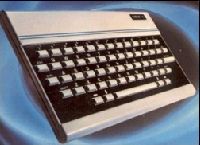

![]()
| Before the Oric the
company known as Tangerine Computer Systems ltd designed
computers. Some of the designs were sold off to be made
by other manufacturers. The most successful computer they
made was the monochrome Microtan 65. This was supplied in
kit form, as were several of the early machines, like the
ZX80 and ZX81. The success of the Microtan and the growing market for home computers prompted Tangerine to design a colour home computer. Oric Products International ltd was set up to produce this new computer.A machine was designed - the Tangerine Tiger, but this idea was sold to another company. Microtan 2 with Prestel capability would be the basis for the new Oric. The original design was supposed to have been drawn out on the back of a napkin. A breadboard version was built to test the circuitry ...
... and then a prototype made to show what the real thing would look like.
Now, Jon Haworth's book says the prototype was green and teak(!) and this looks a bit different to that, so maybe this is a different prototype (?) Whatever the case (pun intended), the Oric-1 would soon be introduced to the world Aug/ Sept 1982. The first colour computer under £100. (The 16K version). 16K and 48K version were released but problems started and some machine had to be returned. Various versions of Oric-1 were released as a result.
Oric-1 board with PCB marked 1 - I haven't seen one of these. They would be the earliest version of the printed circuit board (PCB) Oric-1 board marked with a 2 -I've only seen one of these and that was in a magazine article. It makes me wonder if the '1' version was a prerelease version. You can see the number 2 below the 6522 chip in the bottom right corner. (What looks like a number 1 is just a mark to show where a capacitor goes.)
Oric-1 board issue 3 - This is one of the most common boards. it came with many of the Atmoses as well as Oric-1s. The above board has a semi-transparent look to it. Some issue 3 boards are like this and most are not, being like in the picture below. I think they must have switched manufacture midway through production. Here the board is still fitted with hand written EPROMs, but you can see several differences in the board.
Oric-1 board issue 4 - A later board. This time the EPROM has a printed label, but later the EPROMs would be replaced by a single specially manufactured ROM. This would mean the small IC11 chip (below the speaker, inbetween it and the cound chip marked GI).
You'd think this board would be the one that was used on the later Atmos computer - It was, but so was the issue 3 board. Maybe this was because they had a lot of issue 3 boards in stock or maybe the issue 4 wasn't such an improvement and they returned to the issue 3 design - who knows ? This (below), is the 16K version of the issue 3 board. It has the new ROM fitted and no IC11. You can see the big gap where all the RAM has been removed leaving only 16K. If you work it out you'll se that the 48K Oric has 64K RAM !!!
The last main difference you'll find on Oric-1s is found in the logo. This is the grey version found on most Oric-1s. I'm not sure if it was cheaper to produce than a colour one or if they just tried to stick to the grey livery of the Oric-1, but they went and changed it later on.
This then is the colour version with RGB colours. Some people seem to think this is exceedingly rare - or that the previous one is. I guess I've seen more of the grey version but neither is rare enough for you to get excited about. I guess it's nice to collect the different versions though so try and get one of each ;-)
|
© Copyright 2000 by S.D.Marshall email me